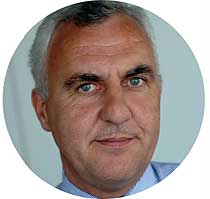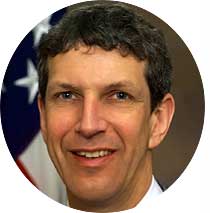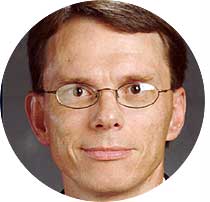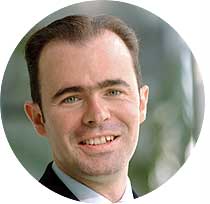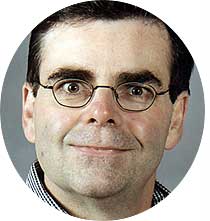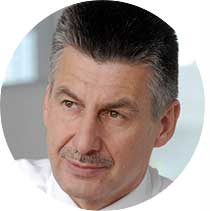Dec 01, 2008>RFID Journal's Watch List, intended to help you assess the future of radio frequency identification. This week, we'll focus on the people to watch; we’ll profile the companies next week, and the technologies the week following. Overall, we think there are many exciting developments on the horizon, so stay tuned.
By John Edwards
Dec. 1, 2008—Radio frequency identification is at a crossroads. During the past six years, it's gone from an obscure technology used by a handful of companies to a technology that is more widely understood and is being adopted in a broad range of business, government and consumer applications. The advancement of RFID can be attributed to the forward-thinking people who recognized its potential, the companies and organizations that boldly tested and implemented it, and the technology developments that made it smarter, as well as easier and less costly to deploy.
But RFID has not reached the level of adoption many envisioned, particularly in the global supply chain. As businesses plan for 2009 and 2010, and consider whether to invest in RFID or other technologies, the looming question is: Will RFID adoption accelerate across industries, or will it forever remain a niche technology delivering value in only a few applications?
That question can't be answered today; it will only be answered over time. To help you see the writing on the wall more clearly, RFID Journal's editors surveyed the RFID landscape to identify the people, the companies and organizations, and the technological innovations that are most likely to influence adoption, either positively or negatively. On the following pages, you'll find our Watch List to help you assess the future of RFID. Overall, we think there are many exciting developments on the horizon, so stay tuned.
Katherine Albrecht
Founder and director of Consumers Against Supermarket Privacy Invasion and Numbering (CASPIAN), Katherine Albrecht is perhaps RFID's harshest critic. From her boycott of Benetton in 2003 to her August 2008 Scientific American article, "How RFID Tags Could Be Used to Track Unsuspecting People," Albrecht isn't afraid to use the media to advance her anti-RFID cause and deter companies and organizations from adopting the technology.
Albrecht believes that both big business and big government are out to control our lives. She claims that RFID tags embedded in products and documents, such as passports and driver's licenses, pose an invasive threat to personal liberty. She also charges that the RFID industry follows a "deploy now and debug later" strategy for correcting discovered security gaps, while taking a "shoot the messenger" approach toward critics who point out RFID security flaws.
Albrecht raises some legitimate concerns about personal privacy. These alerts could help spur RFID developers and adopters to implement stronger technical and operational safeguards. But her tendency to inflate potential threats and to focus on RFID's negative aspects—combined with the negative public attention she generates—could delay or derail beneficial RFID applications.
As the director of global partnerships and projects for GS1, an organization dedicated to the design and implementation of global standards and solutions for improving supply-chain efficiency and visibility, Henri Barthel coordinates BRIDGE (Building Radio Frequency Identification Solutions for the Global Environment), an initiative to help European businesses and organizations deploy RFID and EPCglobal network applications. As BRIDGE's leader, Barthel has the power to influence how quickly RFID is adopted in Europe.
BRIDGE, which is set to run through June 2009, brings together business and university RFID initiatives to identify opportunities, establish business cases, and perform trials and implementations in several key business sectors. The project is currently sponsoring research in several areas, including anti-counterfeiting, manufacturing, pharmaceuticals, products in service, retail nonfood items, reusable assets, and textiles. Financial support for BRIDGE, which involves 30 organizations in six nations, comes from the European Community and various project participants.
Barthel wields influence over BRIDGE by helping participants organize their projects, find funding sources and prepare for yearly reviews. He also serves as the BRIDGE contact for various GS1 national organizations.
Barthel says that by working through BRIDGE, he hopes to provide "guidelines, inspirations and examples" for companies—in areas ranging from telecommunications to pharmaceuticals—that could potentially benefit from RFID. The project has already provided numerous deliverables, he says, in terms of standards and trial results, in all of its major research areas. "We hope to be the catalyst that starts adoption in various business sectors," Barthel says.
Alan Estevez
Serving in the U.S. Department of Defense as the assistant deputy undersecretary of defense for supply- chain integration, Alan Estevez has been instrumental in fostering RFID adoption in the defense sector. Estevez provides program oversight and develops policies for the operation of the DOD's $100 billion logistics operation, and is a key leader of the DOD's implementation of RFID technology to improve logistics support to U.S. forces.
Estevez helps to establish performance parameters and shape the design of new technologies. Since many defense-related RFID technologies, such as vehicle and inventory tracking, are eventually transformed into civilian applications, Estevez's influence is felt across the entire RFID industry. He also works with businesses, such as Wal-Mart, to share RFID experiences. Such collaborations help both parties better understand how technologies and systems can be designed to meet their own needs.
The DOD has been involved in RFID since the technology's development during World War II as an aircraft location tracking technology, observes Michael Liard, research director of RFID and contactless technology at ABI Research. "This, and the fact that it operates some of the largest RFID deployments in the world, means that people look toward the agency as one of the leaders in the space, helping to drive the market," Liard says.
In addition, Estevez is the DOD official with the power to say "go" or "no" to new projects and deployments, Liard adds. Just how many new RFID projects will get the green light from Estevez in the years to come largely depends on the policies of the incoming presidential administration, he notes.
Confidently spanning the worlds of academia and business, Bill Hardgrave, director of the University of Arkansas' RFID Research Center, has become one of the RFID world's key "go-to" people for scores of enterprises planning RFID deployments. Hardgrave and his team are valued for their in-depth knowledge of RFID technologies and systems. He has emerged as both an industry expert and an objective voice, giving a growing number of potential end users in retail and the supplier community increased confidence in tracking and monitoring technologies.
Hardgrave's research has so far presented a generally bullish view of RFID's potential to generate bottom-line benefits. He is widely recognized for his close links to Wal-Mart; his lab conducts studies that show the retailer how RFID can be used most effectively. Recently, with participation from the Council of Supply Chain Management Professionals, the Voluntary Interindustry Commerce Solutions Association, Dillard's and Procter & Gamble, the lab tested and evaluated the use of Gen 2 RFID tags with a variety of clothing and footwear items. The major use cases investigated included product life-cycle management, inventory management, loss prevention, dressing-room management and point-of-sale applications.
Now, as RFID shifts from tests and pilots to full-scale real-world deployments, both current and potential adopters are anxious to see and understand the technology's payoff in various applications. Hardgrave and his team are well positioned to deliver such data. "We're not simply interested in studying RFID as a technology," he says. "We want to measure its impact on business and society."
Carlo Nizam
As head of value-chain visibility and RFID at Airbus, Carlo Nizam has spearheaded one of the most ambitious enterprise-wide RFID deployments. At Airbus, RFID is a key element in an integrated, companywide approach to help streamline business processes and reduce the cost of operations for all value-chain partners. Airbus' bold embrace of RFID, including pilots and deployments in transportation, logistics, manufacturing and assembly-related applications, as well as aircraft operational, maintenance and payload-tracking applications, promises to serve as a model for widespread RFID adoption in many different types of industrial manufacturing.
Next on Nizam's agenda are studies and pilots with Airbus' suppliers and airline customers that will evaluate RFID's applications in fresh areas, such as parts life-cycle tracking. "We're always looking for new ways that technology can benefit us and our partners," he says.
Nizam is understandably proud of Airbus' achievements. "I think we have helped change the perception that RFID deployments are limited to the retail sector," he says. "By using Airbus as an industrial showroom, we have helped convince key suppliers and customers that using RFID as a business radar…really does deliver real, tangible savings, and has helped provide a springboard for large-scale industry adoption without the need for mandates."
While many RFID adopters, such as Wal-Mart, prefer to keep their plans and views close to their vest, Kimberly-Clark has been more than willing to discuss its experiences with RFID technology and Electronic Product Code standards. Much of the credit for Kimberly-Clark's openness goes to Mike O'Shea, the company's director of RFID strategy. O'Shea is a strong believer in EPC RFID, and that widespread adoption will deliver tangible financial benefits across the supply chain.
As an active participant in EPCglobal, Kimberly-Clark has worked with other industry leaders to establish the Gen 2 standard. The company has even created its own state-of-the-art, 7,500-square-foot RFID research lab in Neenah, Wis., which allows it to test tags in an environment that very closely matches real-world supply-chain conditions. "Other than Hewlett-Packard," O'Shea says, "we're probably the only end user to have that type of facility."
Working in a field where adoption has traditionally been driven by retailers, O'Shea says his biggest challenge is to convince fellow suppliers that EPC RFID is good for them as well as their partners. "My efforts and K-C's efforts have been focused on pushing a standards-based solution for the adoption of RFID," he says. O'Shea's biggest worry is that de facto standards developed by vendors could lead to compatibility and scalability issues, potentially hampering RFID adoption and growth. "It's difficult to make any investments when you're not sure what direction you're heading in and what's best going to meet your needs," he says. "That's why we're working with and supporting EPCglobal."
Doug McMillon
Although overshadowed by the groundbreaking EPC RFID projects launched by its corporate parent, Wal-Mart, warehouse retail chain Sam's Club is hardly a slouch at the tagging and reading game. In fact, Sam's Club CEO Doug McMillon made waves in January 2008 by setting an ambitious timetable for rolling out EPC RFID at the "sellable unit" level.
Sam's Club mandated that suppliers apply EPC RFID tags to all sellable units shipped to its distribution centers or stores by Oct. 31, 2010. Other requirements include pallet-level tagging by the end of January 2009, and case-level tagging by Oct. 31, 2009. Service fees, ranging from $2 to $3 per pallet, will be charged to suppliers that do not include EPC RFID tags as instructed. The requirements are believed to apply to most if not all of Sam's Club's suppliers, with no allowances made for low-cost or low-margin products.
If Sam's Club can stick to its ambitious timetable, the program's impact could resonate across the retail landscape, helping to make item-level tagging more common. Paula Rosenblum, a managing partner at RSR Research, notes that McMillon has likely realized that item-level tagging's greatest value lies in its potential to supplant and replace store inventories. An interest in using item-level RFID tagging for rapid checkouts might be another reason for Sam's Club's interest in the technology. "The ROI there is tangible," she says, "and every retailer knows it."
As managing director of MGI Metro Group Information Technology, the IT service provider for European retail giant Metro Group, Gerd Wolfram has been the guiding force behind the company's pioneering EPC RFID projects. Metro started introducing EPC RFID along its entire supply chain in November 2004, the first retail group in Germany to do so. To date, the company is tracking goods arriving at all of its Metro Cash & Carry wholesale stores and distribution centers in Germany, as well as at 300 of its Real hypermarkets. The initiative marks the largest operational EPC RFID deployment in the European retail sector. In August, Metro Group and DHL announced plans to begin tracking pallets shipped to the 89 Metro Cash & Carry stores in France.
During the years, Wolfram has been an ardent EPC RFID supporter. And now, as some European retailers have started pulling back from the technology, Wolfram is actually pushing harder for EPC RFID adoption. He plans to continue leading by example.
"In the beginning," he says, "we set out with an ambitious goal of utilizing RFID along the entire retail value chain. We are still committed to this goal, because we are convinced that RFID will bring collaborative benefits for all partners involved. Therefore, we'll follow our strategy by combining the operative usage of RFID in retail logistics with pilot projects for other use cases, such as at the item level."
Additional Stories
• RFID Journal's Watch List: Companies and Organizations to Watch
• RFID Journal's Watch List: Technologies to Watch
What do you think the future holds for RFID adoption—and who and what is on your watch list? We'd like to know. Share your thoughts and opinions by writing to us at
editor@rfidjournal.com.

